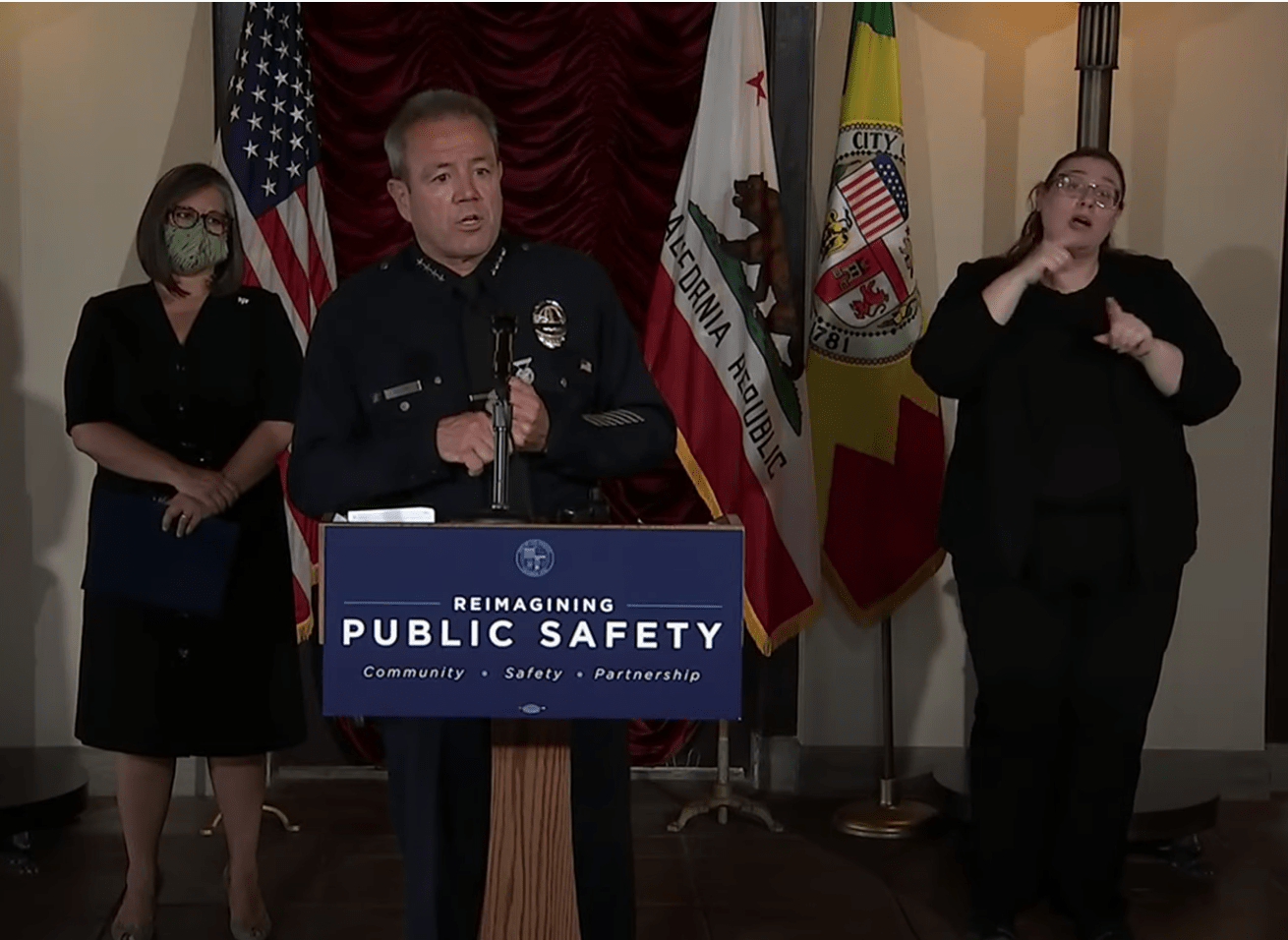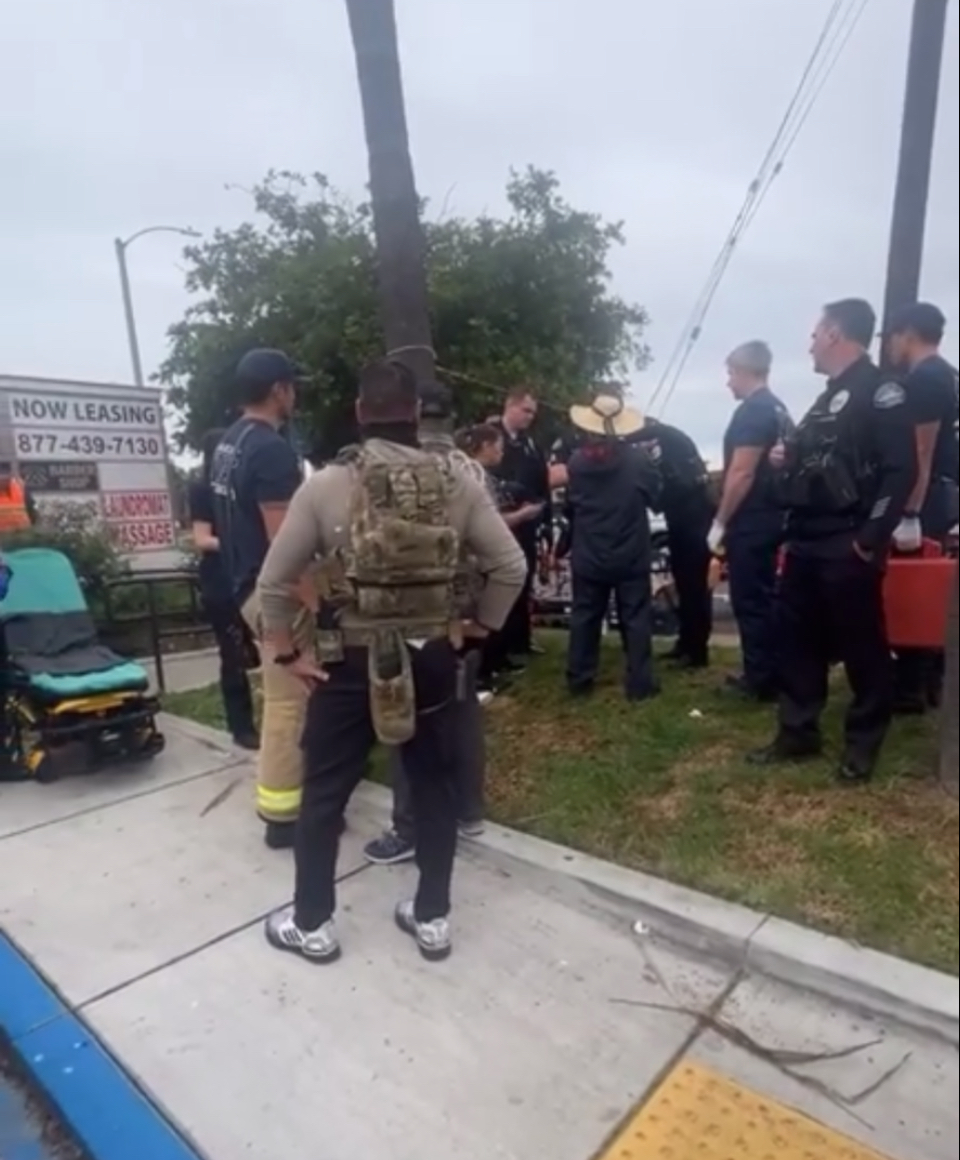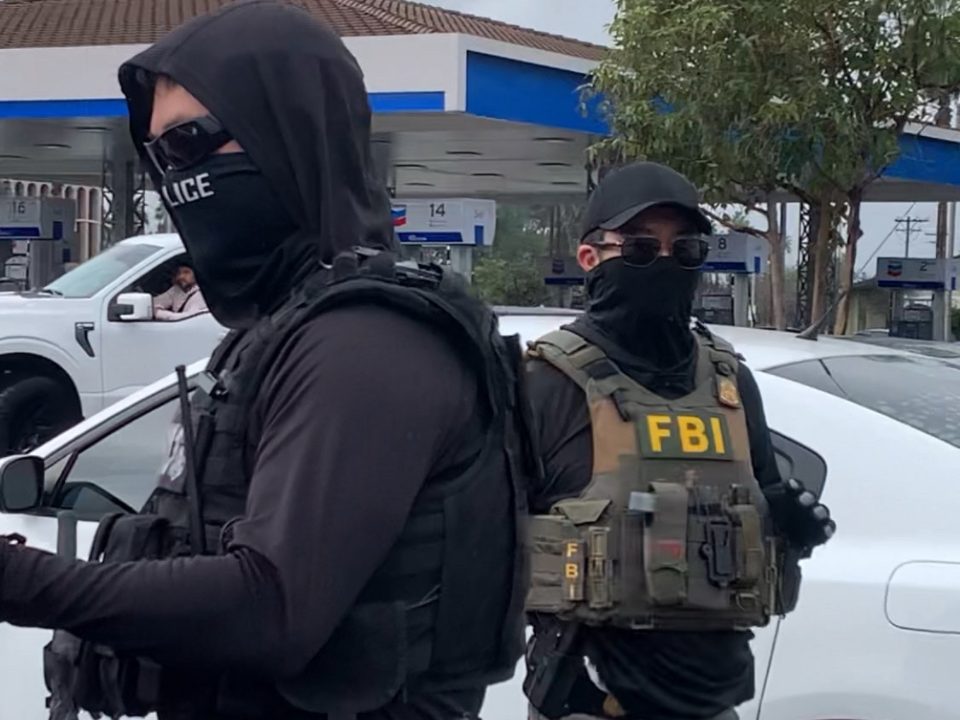Los Angeles Police Department Chief Michael Moore this week addressed some of our reporters questions about police brutality, the mistreatment of women, trans and non-binary protesters, and the possibility that the Trump administration would send unidentified, clandestine federal officers into Los Angeles. The chief spoke briefly after a press conference about the department’s community policing program. See video below.
Mayor Eric Garcetti and several others also spoke at the press conference where the city announced an expansion of the Community Safety Partnership that puts police directly in working-class communities of color. The program, the city argues, will help change policing into being less about arrests and more about communication.
However, it comes at a time when activists in those same communities are calling for a complete reimagining of the way policing is done. Fueled by Civil Rights protests resulting from the murder of George Floyd by a Minneapolis police officer, the city recently cut $150 million from the LAPD’s billion dollar budget.
The modest cuts have not placated calls to defund the police led by Black Lives Matter. Protests continue every day in Los Angeles, mass arrests follow, and true Civil Rights reforms have yet to materialize. With all that at stake, L.A. Taco has analyzed the chief’s responses to these essential questions.
Video snippet via City of L.A./Youtube. Chief Moore answered the rest of the questions off camera. His answers were tapped for us by the pool reporter, Cindy Chang of the L.A. Times. That's below.
L.A. Taco: What is the mayor doing to prevent federal officers from coming to LA and mistreating protesters and will LAPD be held to those same standards?
Mariah: Moore’s response here is interesting. He says that “The security of federal buildings here in Los Angeles is safe,” this appears to be in reference to President Trump’s justification of federal agents being sent to Portland to “protect federal property.” This implies that the police chief believes federal buildings are safe; but could suggest that should he feel that federal buildings are not secure, he might align with the president’s justification for allowing unmarked federal agents to occupy Los Angeles.
Moore’s apparent comfort with the idea of federal agents coming to Los Angeles to quell protests in a Portland fashion (which involved unmarked agents essentially kidnapping protesters from the streets) was further implied when he said, “We welcome the federal law enforcement agencies support[ing] us in reduction of gang violence and reduction, particularly of gun violence.” This is interesting because Moore openly says he welcomes federal law enforcement should there be “gang violence.” It must also be noted that we did not ask anything about “gangs,” and the term “gang violence” is often a racist dog whistle (which Trump uses quite a bit).
Moore’s response is in stark contrast with the mayors of Chicago, Seattle, Portland, Ore., Albuquerque, N.M., Washington, D.C., and Kansas City, Mo. who have all signed a letter asking Congress to block Trump from sending federal agents to their cities. For his part, Mayor Garcetti has signed a letter with 15 other mayors calling for a congressional investigation into the use of unidentified federal officers.
It’s also worth noting, as my colleague Lexis-Olivier Ray pointed out, that there was an unconfirmed report of BORTAC (Border Patrol Tactical Unit) personnel being spotted at the Wilshire Federal Building on July 26th.
As a civilian, I’m very concerned given the current political and national climate.
Also, there is no comment on any standard for how police should treat protesters.
L.A. Taco: How do the reforms that you're undertaking address allegations that officers are harassing and otherwise mistreating women, trans and non binary people during mass arrests?
Mariah: This is essentially a non-answer. Moore says that he’s talking about “building trust in communities,” however if I was the person physically asking the question, I would definitely push a little on this answer. From my own reporting, and from various social media posts, women of color and trans people appeared to bear the brunt of LAPD violence during the mass arrests. It could be argued that building trust with communities would also involve addressing the police brutality that occurred during and after the mass arrests that occurred in late May and early June.
It’s also unclear how a study of such arrests would be carried out and what “a path forward” implies.

L.A. Taco: Does LAPD have access to OC spray (pepper spray) or tear gas? In what situations is tear gas used? And have either pepper spray or tear gas when used against demonstration.
Lex: L.A. Taco and other news outlets have reported first hand accounts of “tear gas” being used against protesters but city leaders have consistently pushed back against those claims.
In a June interview with Matt Ferner, editor of The Appeal and Mayor Eric Garcetti, the mayor said, “we haven’t used tear gas in 50 years,” when discussing police violence specifically against protesters. Later, when Ferner asked Mayor Garcetti if he would support a ban on less-lethal weapons in Los Angeles, Mayor Garcetti said, “We don’t use tear gas so we don’t need to, and it’s not part of our policy, and we don’t have that. We haven’t done that in over 50 years.”
Josh Rubenstein, spokesperson for the LAPD, told me that the department has access to CS gas (AKA “tear gas”) but that it hasn’t been used in crowd control situations since the ‘60s. However, he added that CS gas is used in other policing situations. A recent video released on July 22 by the department shows an LAPD SWAT unit shooting tear gas through a window at a barricaded suspect. According to Rubenstein this is one of the few examples of when tear gas is used.
Chief Moore’s comments at yesterday’s press conference, reconfirm what LAPD policy and witness accounts have already told us. Uniformed personnel carry pepper spray on them and the department has access to “tear gas.”
Both oleoresin capsicum (pepper spray) and 2-chlorobenzalmalononitrile (“tear gas”) are part of a wider spectrum of “chemical irritants” and both are considered “riot control agents” by The Center For Disease Control. The LAPD considers both pepper spray and “tear gas” a “chemical agent.”
The most recent LAPD directive on pepper spray describes what it’s like to get hit: “Generally, there will be a burning sensation as well as redness of the eyes. The mucous membranes may swell, and cause uncontrollable coughing, gagging or gasping. Exposed areas of the skin may become inflamed causing an intense burning sensation and redness.”
In a 2017 podcast with LAPD spokesperson Josh Rubenstein, Michel Moore spoke for over 30 minutes about crowd control. Headed into retirement at the time, Moore reflected on the LAPD’s violent history at demonstrations: "I think we’ve changed particularly in the last nearly two decades. The DNC in 2000, I think, was a real turning point for the LAPD in understanding its role in facilitating First Amendment protected activities. And in that role, the management of those situations could be done in a manner different then with helmets and batons displayed and movements in a military fashion or style or influence."
L.A. Taco reached out to Chief Michel Moore for further comment regarding the use of pepper spray during protests but has not yet received a response.







